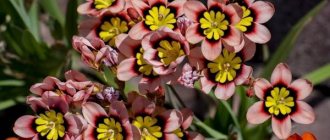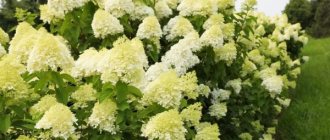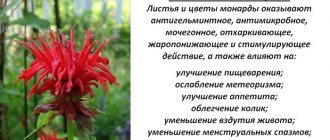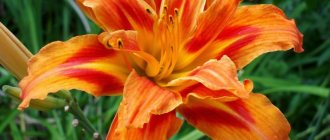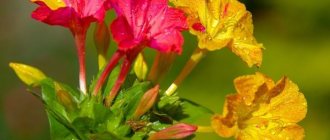- October 25, 2018
- Flowers
- Alexander Nedashkovsky
Garden hydrangea is one of the most exquisite and beautiful plants. Its beautiful multi-colored caps form lush inflorescences that always decorate the garden. Hydrangea flowers begin to bloom in mid-summer and delight their owners until the end of autumn. During all this time, plants need proper care.
Wonderful hydrangeas
The hydrangea plant belongs to the Hydrangeaceae family. In total there are about 100 varieties of it. Among them there are upright, climbing, evergreen, deciduous, heat-loving and frost-resistant forms. In temperate latitudes, hydrangea flowers are bushes reaching a height of 1.5 m. The plants have large green oval-shaped leaves with wavy edges. From mid-summer they begin to bloom and delight with their beauty until the end of autumn. When in bloom, the plants are covered with beautiful multi-colored caps-inflorescences, behind which the leaves are practically invisible. Their color depends on the acidity level of the soil. Flowers can be pink, cream, white, purple, blue or lilac. Their beauty can be appreciated by the photos of hydrangeas given in the article. Planting flowers and caring for them require certain knowledge so that gorgeous flowers delight with their beauty.
Professional gardeners note that the crop is relatively unpretentious. That is why it is actively planted in gardens, parks, garden plots, near houses and in public gardens. Depending on what goals landscape designers pursue, they choose liana forms, shrubs or plants in the form of a small tree.
Species features
Hydrangea grows as bushes, small trees and vines. Shrubs are often planted in gardens. These are mainly deciduous plants, although evergreen species are found in the southern regions.
The biggest advantage of hydrangeas is their long, lush flowering. The first buds appear in spring and bloom until frost. The inflorescences completely cover the bush with large balls, panicles or shields. Most species have white flowers.
Only large-leaved hydrangea has a wide range of colors - from snow-white to deep red.
Hydrangea is sensitive to the composition of the soil in the area where it grows. On neutral soil the flowers are pink, but on acidic soil the same shrub blooms with blue flowers.
The plant absorbs all active substances from the soil through the root system. The flower is caused to turn blue by an increased dose of aluminum in acidic soil. It is precisely these biological features of hydrangea that the famous researcher Efim Fomin describes in the book.
Types of hydrangeas
There are many varieties of hydrangeas. Flowers are extremely popular due to their beauty and colorfulness. Gardeners are especially fond of pink and blue large-leaved hydrangeas. For central Russia, the most suitable variety is paniculate or tree-like, since they are very resistant to frost.
In our latitudes, rough, oak-leaved, and large-flowered hydrangeas are also common. These varieties are more thermophilic and therefore require shelter for the winter.
Hydrangea paniculata flowers have one important feature. They are capable of changing color under certain conditions. For example, white flowers of the Laimlat hydrangea variety can become lime. And Sunday Frize's initially green inflorescences become pink by the end of flowering.
How to change the color of flowers?
It is worth saying that the color of hydrangea flowers (photo given in the article) may change. However, only large-leaved varieties are subject to such changes. The color depends on the pH level of the soil, as well as the presence of aluminum in it. To obtain the desired color of the plant, it must be watered with special fertilizers:
- Blue. To get a blue hydrangea paniculata flower, you need to enrich the soil with aluminum. It is best absorbed in acidic soil. In specialized stores you can purchase a water-soluble fertilizer (aluminum sulfate), which should be used with each watering. This will help maintain the blue tint of the plant. For irrigation, 0.5 kg of aluminum sulfate per square meter is required.
- Blue tint. Flowers acquire this color only in acidic soils. You can achieve the desired result by watering the plant with aluminum phosphate or simple sulfur. The application of such fertilizers lowers the pH level. In the future, the bushes must be watered occasionally with a solution of aluminum sulfate in order to maintain the required acidity in the soil. In addition, crushed sawdust, apple cider vinegar, and high-moor peat can be added under the bushes - substances that increase the acidity level of the soil.
- Pink hydrangeas grow in alkaline and neutral soils. The plant absorbs aluminum from the soil, which gives the flowers a pink tint. To achieve the desired shade, you can also water the bushes with a solution of potassium permanganate or fertilize them with dolomite flour or ground lime. To maintain the pink color, regular application of nitrogen and phosphorus fertilizers is required.
- A mixture of blue and pink shades or purple on a bush can be obtained by watering the plant with a solution of iron sulfate.
Soil requirements
Of great importance for Hydrangea is the land, which at the landing site should be:
- fertile,
- loose,
- air and water permeable,
- with neutral acidity or slightly acidic. Heavy clay acidic soil should be neutralized with dolomite flour (2 kg of flour per 5 sq. m of area). This procedure is good to carry out in autumn days or three weeks before spring planting;
- not alkaline soil. To protect the plant from such areas, it is necessary to avoid areas near the washbasin or the place where water used in the household is drained.
What do hydrangea flowers look like?
Among the variety of hydrangeas, it is worth highlighting the most popular forms:
- The tree-like variety was developed in North America. The bushes reach three meters in height. The spherical inflorescences are usually cream or white. Each of them reaches 15 cm in diameter. The plant blooms from June to the end of September.
- Large-leaved hydrangea is native to Japan and China. Shrubs of this species grow up to four meters. The inflorescences of the plant look like shields, which can have different shapes and colors.
- Hydrangea paniculata grows in Japan and China, as well as in the south of Sakhalin. The plant looks like a shrub or tree, reaching a height of 10 meters. The flowers of the crop are collected in large inflorescences of pink and white shades.
- Petiolate hydrangea is also called climbing, creeping or climbing. It grows on Sakhalin, Korea and Japan. This variety of plant is capable of rising 25 meters in height with the help of aerial roots. The plant has white and pink inflorescences. It is actively used to decorate gazebos and walls of houses.
- Oakleaf hydrangea came to us from the southern regions of the United States. The culture received its name due to the similarity of its leaves to oak leaves. The paniculate inflorescences of the plant acquire a bright crimson hue in autumn.
Cultivation care
Every novice gardener dreams of having beautiful flowering plants on their plot, like in glossy photos. Planting hydrangea flowers and caring for them in the future are not particularly difficult procedures. And yet it is necessary to know all the nuances of the content of such a culture. Caring for bushes should begin in early March. It is necessary to check the condition of plants under shelters in advance. With the arrival of warmer weather, you need to start ventilating the bushes little by little. But it’s not worth opening the plants completely yet. A delicate crop may react poorly to temperature changes and weather surprises. During the thaw, it is necessary to ensure that there is no melt water at the roots, which can harm the flowers. Garden hydrangea can be fully opened after wintering only after the threat of frost has passed.
In the spring, it is very important to prune correctly, especially if it was not done in the fall. Pruning is a very important element of hydrangea care. Flowers will delight you throughout the summer if you prepare the bushes correctly. Plants need to be pruned in March. The sap flow of the bushes begins early, so it is important to form the plant in time. Otherwise, after pruning, the hydrangea may begin to “cry,” which invariably leads to weakening of the bushes.
In mid-April, the air warms up significantly and the soil thaws. At this time, hydrangeas begin to be fed. During the season, young shoots grow up to 50 cm, so the plant needs active nutrition. Experts recommend using nitrogen fertilizers for fertilizing. If you want to get a beautiful flower, you can pamper hydrangea with organic fertilizers. This will extend the flowering period.
As soon as young leaves begin to appear on the plant, the ground around the bush must be mulched with humus or manure. This will prevent the active growth of weeds.
Landing in the ground
If you plan to plant garden hydrangea (photo is given in the article), then this should be done in autumn or early spring. In cold climates, it is better to plant in the spring so that the plants have time to take root well and prepare for the first winter. It is very important to choose the right place for your hydrangea. The flower loves acidic soils. It can bloom well not only in the sun, but also in partial shade.
Beginning flower growers should know that the crop has very fragile surface roots, which very actively grow in width. Therefore, the hole for the plant must be made wide, but shallow. Herbaceous hydrangeas in summer cottages must be planted in such places that the sun illuminates them for at least six hours during the day. But at the same time, the rays should not burn the plant in the heat.
Shade-tolerant varieties include Phantom, Limelat, as well as tree-like and oak-leaved varieties. Hydrangea is a plant that does not like stagnant water. Therefore, when planting on clay soils, it is necessary to ensure proper drainage. It is necessary to fill the bottom of the prepared hole with crushed stone or broken brick.
Immediately before planting, the roots of the plant should be soaked in a bucket. A mixture of 4 buckets of humus, a bucket of pine needles and peat must be poured onto the drainage layer in the planting hole. You can add garden soil in small quantities. Experienced gardeners recommend immediately applying superphosphate and complex fertilizer.
The brightness and beauty of garden hydrangea flowers largely depend on fertilizing and watering. If there is a lack of nutrition, the inflorescences may be small and pale. You should plant the plant in your summer cottage carefully. The top of the soil must be mulched. It is very important to water the bush well during planting. Not only the soil in the hole should be wet, but also the earthen ball in which the hydrangea grew before. Subsequent care consists of regular watering (once a week). It is worth remembering that different varieties require different amounts of water.
With the arrival of summer, buds are laid - future hydrangea flowers. Garden flowers during this period need intensive feeding, which contains a lot of potassium and phosphorus. Large-leaved hydrangeas form inflorescences in July. If desired, you can change the color of the crop at this time. To do this, you need to water the plants with special preparations.
Fertilizer
Feeding plays an important role in care. Hydrangea Mix needs a variety of supplements. There are the following methods and rules of fertilization:
- If yellow leaves appear on the plant, it is necessary to acidify the soil. Mix 2 liters of water and 10 drops of lemon juice. Water once every 2 weeks.
- To accelerate flowering, spray hydrangea Mix with the following solution: 2 liters of water and 0.2 grams of gibberellin.
- In February it is necessary to carry out the first feeding of the plant. A professional complex fertilizer with a low alkali content is suitable for it.
- During growth and flowering, fertilizing should be done 2 times a month.
- From time to time you should add a little potassium permanganate to the water for irrigation. It will destroy bacteria and fungi.
Watering
Many novice gardeners dream of beautiful plants in their plots, like in the photo. Planting garden hydrangea and caring for it in the future is not difficult. Still, it is necessary to remember that for abundant flowering the plant must be provided with regular watering. It should receive a lot of moisture, especially if it is in a sunny place. To ensure continuous flowering in July, you can apply a third fertilizing in the form of humic or phosphorus-potassium fertilizers.
Hydrangeas are very sensitive to watering. It is better to use warm water to moisten the soil. The plant does not like drought, so it needs regular watering. Light drying of the top layer of soil is acceptable, but no more.
Experts recommend using only soft water for irrigation. It could be rainwater. You can also use tap water, but then it will have to stand for five days. The sensitive root system of hydrangea does not like low temperatures, so water with a temperature above + 15 degrees is suitable for irrigation. On average, at least 16 liters of liquid per week must be poured under each bush. Watering should be done in the evenings or early mornings.
Conditions of detention
The room in which the flower will be located must be sufficiently lit, without drafts. The most suitable place for keeping Hydrangea Mix is on a windowsill or next to it. However, it is necessary to ensure that the leaves of the plant do not lean against the window glass. In frosty conditions this can harm the plant. Direct exposure to sunlight is also unacceptable. It is better to use a special protective film or curtain. The ideal temperature for Mix hydrangea is within 20 degrees above zero, which significantly distinguishes it from indoor hydrangea, which can be read about in the article: https://sadovnikam.ru/414391a-gortenziya-komnatnaya-uhod-v-domashnih-usloviyah.
Wintering culture
With the arrival of autumn, hydrangeas need to be prepared for wintering. In September, the plant still needs to be watered abundantly and the soil mulched. In October it is necessary to prune the bushes.
If you purchased flowering plants in the summer, you need to bury them along with the pots in the beds, covering them with dry leaves on top. Next, the hydrangeas are covered with lattice boxes, which are covered with film on top, leaving the side surfaces open. The plant will overwinter well in such a shelter.
According to experts, most decorative varieties need winter shelter. Even if there is no threat of frost, it is better to cover the bushes with special material.
There are several more options for forming the right shelter for the winter. The stems of the plant can be bent to the ground and secured with staples, and the base of the bush can be sprinkled with peat. Arcs are installed on top, which are covered with non-woven material in several layers. Before frost arrives, you can leave holes in the shelter for ventilation.
In addition, you can bend the shoots of the plant to the ground and cover it with spruce branches on top, then cover it with peat and cover it with a sheet of slate. This design is very effective in combating frost.
The third method involves building a frame around a bush, which is covered with pine needles and leaves, and covered with fiber from the outside. The top cover is protected from excess moisture.
With the arrival of spring, the plants open gradually. At first, only ventilation is provided for them. The shelter can be completely removed only after stable warm weather has established.
Proper pruning
Proper care is the key to obtaining beautiful hydrangea flowers. Garden flowers are a decoration for any area. To achieve abundant and beautiful flowering, it is necessary to prune the bushes. For beginning gardeners, pruning means removing dry twigs and leaves. Actually this is not true. Hydrangeas need crown formation.
In the first year, the shoots of the plant are shortened to a strong bud. In autumn, only weakened shoots can be pruned. In the second year, the branches are shortened to increments, and in the third, dry shoots are removed. In the future, pruning of weak branches is carried out as needed.
It is worth knowing that some varieties of crops form flowers only on last year’s shoots, so only faded inflorescences are removed from such plants. In August, flower buds are already forming on the bushes for next year. Drastic cutting of such plants can deprive them of flowering in the future.
Interesting facts
- Hydrangea got its name in honor of the princess of the Roman Empire.
- According to archaeologists, the plant existed several thousand years ago.
- In the language of flowers, hydrangea means modesty and frugality.
- Asian gardeners call the botanical beauty “purple sun”.
- According to ancient legend, on Buddha's birthday, hydrangea flowers fell from the sky.
How to propagate hydrangea?
Beautiful photos of garden hydrangea flowers will not leave anyone indifferent. Every gardener wants to grow wonderful plants in their garden. How does hydrangea propagate? You can grow a new bush using cuttings, seeds, by dividing the bush or layering.
Using seeds for propagation is a very simple method. Seed material is planted in open ground in March without prior stratification. Unfortunately, this way is not the fastest. Plants grown from seeds will have to wait a very long time for flowering.
To quickly get excellent results, you should propagate bushes by cuttings. To do this, in the summer, shoots are cut, which have two pairs of leaves. The length of the branches should not exceed 17 cm. Oblique cuts are made on the cuttings, located a centimeter below the buds with leaves. They are powdered from below with root formation enhancers, and then planted in containers with a light substrate. The cuttings are covered with a greenhouse on top, and the pots themselves are placed in partial shade. On average, the rooting process takes up to 6 weeks. Caring for cuttings is quite simple. It consists of regularly moistening the soil and ventilating the greenhouse. The shelter can be removed only after young strong shoots appear. You can count on flowering of hydrangeas obtained from cuttings as early as next year.
The fastest and easiest way to propagate hydrangeas is by dividing the bush. Sometimes the culture is propagated using layering. To do this, shoots that are already more than a year old are dug in, leaving some on the surface. In the fall or spring of next year, the branches are separated from the mother bush and transplanted to a new location. Hydrangeas are practically not propagated by grafting.
Reproduction
You can propagate hydrangea yourself. A popular way to do this is to use cuttings. They can be cut during the spring pruning process, and it is also possible to take annual cuttings in the summer. then proceeds as follows:
- add a substrate of peat and sand, taken in equal quantities, to pre-prepared containers;
- each cutting must be treated with a stimulant to form a root system;
- Afterwards, the cuttings are rooted in the substrate, digging in drops;
- watering is carried out as the soil dries;
- Over the course of two years, young plants will strengthen their root system and increase leaf mass, while in winter they should be kept in a warm room.
Pests and diseases
Unfortunately, hydrangeas, like other crops, are susceptible to diseases. For example, a lack of iron leads plants to the appearance of chlorosis. The disease can be recognized by lightening and yellowing of the foliage. To treat the disease, it is necessary to use iron-based preparations in chelated form. For example, you can purchase “Antichlorosis” or “Ferovit”. You can prepare the medicinal mass yourself. To do this, dissolve 2 g of iron sulfate and 4 g of citric acid in a liter of water. The resulting solution is sprayed onto the plant leaf by leaf, and if necessary, you can water it at the root.
Hydrangeas are prone to white rot. It can be recognized by the white coating on the shoots. Gray rot causes softening of plant tissues. In addition, a gray coating appears on diseased plants.
No less dangerous is powdery mildew, which causes the formation of yellow-green spots on the foliage that turn brown over time. Treatment of all these ailments is carried out using fungicides: “Fundazol”, “Chistotsvet”, “Topaz”.
The most dangerous pest is the spider mite. Its presence can be judged by small yellow spots that gradually merge into a marble pattern.
Aphids, which can be seen on the back of the foliage and on the shoots, are also dangerous for hydrangeas. You can get rid of dangerous pests with the help of “Fitoverma”, “Akarina”, “Aktara”.
Places of growth
We have already mentioned that different types of hydrangea differ in frost resistance. Therefore, some varieties can be grown almost throughout the entire territory of Russia, while others can only be grown in the south of the country. Paniculate and tree-like hydrangeas are the most resistant to frost. Frost-resistant varieties of these species are now grown even in Siberia. But this does not mean that plants do not need shelter. In central Russia you can grow many varieties of large-leaved and petiole hydrangeas. But even in this region, plants must be covered for the winter. The southern regions are most favorable for growing hydrangea. Oak-leaved, ash-colored, and radiant varieties feel good here.
If you decide to grow hydrangea, then you need to choose the right variety depending on the region of your residence. Certain types of plants have their own characteristics of planting and care. For example, tree-like forms have long and massive shoots that need good support. It is necessary to maintain a certain distance between plants, which depends on the goals being pursued. If you intend to erect a gazebo in the shortest possible time, then the bushes can be placed closer to each other. In flower beds and gardens, hydrangeas are planted away from each other because their root system grows quickly.
Instead of an afterword
Hydrangea is a wonderful crop that can decorate any personal plot and garden. According to avid gardeners, the plant needs careful care. To obtain lush flowering, you need to make some effort. If you decide to grow beautiful flowers on your plot, you need to understand in advance all the intricacies of caring for them.
Hydrangeas are a capricious crop that requires regular watering and fertilizing. Only adding nutrients will allow you to get lush inflorescences that will delight you for a long time. For certain varieties, applying fertilizers allows you to adjust the color of the flowers, which gives gardeners the opportunity to be creative.
Site requirements
When growing charming bushes, you should know what properties the site should have. Otherwise they may die.
Important features of the site include:
- the place should be darkened so that only in hot hours (from 12 to 15) the hydrangea does not receive direct rays of the sun, otherwise the flower will not delight with lush flowering;
- reliable shelter from drafts and cold winds. It is better to plant this delicate creature on the south side of the house. Bushes should be protected from cold winds by a fence or other trees and shrubs, without shading the sun;
- On the site, groundwater should be located at least one and a half meters from the ground. Bushes should not be in water. The beds for planting should be made high from 0.50 m and above;
- Black currants, white acacia, herbs, and garlic should not be adjacent to the flower.

